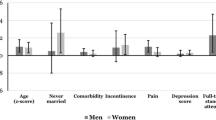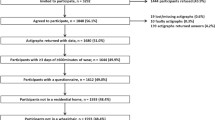Summary
Background
Falls are common in physically active older people due to their increased exposure to hazardous situations. However, most studies of the characteristics and circumstances of falls are based on frail older people.
Objective
To describe the location, time, cause, injuries and medical treatment associated with falls in a physically active group of older people.
Methods
Prospective falls data over a 12-month period were obtained from 293 people (163 men and 130 women) aged between 70 and 90 years who took part in the “Standfest im Alter” study, a randomized controlled trial conducted in Erlagen, Germany.
Results
During the study period, there were 322 falls. 122 participants (42%) fell at least once and 62 (21%) fell on multiple occasions. The typical fall occurred outside the home during leisure activities, at midday or in the afternoon and did not result in injury or admission to hospital. There were no differences in the rate of falls according to gender; however, fall location, time of fall, fall injury and visits to the doctor after the fall were all influenced by gender.
Conclusions
The results of this study provide useful insights into the characteristics and circumstances of falls in physically active older people living in the community, which may assist with the development of future falls prevention activities.
Zusammenfassung
Hintergrund
Körperlich aktive ältere Menschen stürzen häufig bedingt durch größeres Ausgesetztsein von gefährlichen Situationen. Jedoch sind die meisten Studien zu den Umständen und Charakteristika von Stürzen in einer Population älterer motorisch eingeschränkter Menschen durchgeführt worden.
Forschungsgegenstand
Beschreiben von Ort, Zeit, Sturzursache, Verletzungen und medizinische Behandlung bei einer aktiven Gruppe älterer Menschen.
Methoden
Prospektive Sturzerhebung über 12 Monate bei 293 Teilnehmern (163 Männer und 130 Frauen) im Alter von 70 bis 90 Jahren, die an der randomisierten, kontrollierten Studie Standfest im Alter Erlangen, Deutschland teilnahmen.
Ergebnisse
Während des Erfassungszeitraums wurden 322 Stürze gemeldet. 122 Teilnehmer (42%) stürzten mindestens einmal und 62 (21%) stürzten mehrmals. Der typische Sturz ereignete sich außer Haus während einer Freizeitaktivität, am Mittag oder Nachmittag und bewirkte keine Verletzungen oder einer Krankenhauseinweisung. Es gab keinen Unterschied in der Sturzrate zwischen den Männern und Frauen, jedoch waren der Ort, Zeit des Sturzes Sturzverletzungen und Arztbesuche geschlechtsabhängig.
Diskussion:
Die Resultate dieser Studie geben wertvolle Hinweise über Umstände sowie Charakteristika bei Stürzen in einer aktiven älteren, selbstständigen Kohorte, die helfen können entsprechende Interventionsprogramme zur Sturzprävention für diese Population zu entwickeln.
Similar content being viewed by others
Literatur
Prudham D, Evans JG (1981) Factors associated with falls in the elderly: A community study. Age Ageing 10:141–146
O’Loughlin JL, Robitaille Y, Boivin JF, Suissa S (1993) Incidence of and risk factors for falls and injury falls among community-dwelling elderly. Am J Epidemiol 137:342–354
Campbell AJ, Borrie MJ, Spears GF, Jackson SL, Brown JS, Fitzgerald JL (1990) Circumstances and consequences of falls experienced by a community population 70 years and over during a prospective study. Age Ageing 19:136–141
Lord SR, Ward JA, Williams P, Anstey KJ (1993) An epidemiological study of falls in older community-dwelling women: the Randwick Falls and Fractures Study. Aust J Public Health 17:240–245
Speechley M, Tinetti M (1991) Falls and injuries in frail and vigorous community elderly persons. J Am Geriatr Soc 39:46–52
Northridge ME, Nevitt MC, Kelsey JL, Link B (1995) Home hazards and falls in the elderly: the role of health and functional status. Am J Public Health 85:509–515
Oswald WD (2006) Neuropsychological Ageing Inventory (NAI). Hogrefe and Huber, Göttingen
Brunnhuber S (2001) Gestalt theory of V.V. Weizsacker from the viewpoint of the psychology of emotions. Fortschr Neurol Psychiatr 69:322–329
Antonovsky A (1979) Health, stress and coping: New perspectives on mental and physical wellbeing. Jossey- Bass, San Francisco
Olbrich E (1987) Kompetenz im Alter. Z Gerontol Geriat 20:319–330
Fischer K (2001) Einführung in die Psychomotorik. Reinhardt, München
Pache D (1998) Zur gegenwärtigen Situation des Alterssport in Deutschland Daten und Anregung für eine Förderung. In: Mechling H (ed) Training im Alterssport. Hofmann, Schorndorf, pp 135–141
Lamb SE, Jorstad-Stein EC, Hauer K, Becker C (2005) Development of a Common Outcome Data Set for Fall Injury Prevention Trials: The Prevention of Falls Network Europe Consensus. J Am Geriatr Soc 53:1618–1622
WHOQOL Group (1995) The World Health Organization Quality of Life assessment (WHOQOL): position paper from the World Health Organization. Soc Sci Med 41:1403–1409
Hauer K, Lamb SE, Jorstad EC, Todd C, Becker C (2006) Systematic review of definitions and methods of measuring falls in randomised controlled fall prevention trials. Age Ageing 35:5–10
Luukinen H, Koski K, SLK (1996) The relationship between outdoor temperature and the frequency of falls among the elderly in Finland. J Epidemiol Community Health 50:107
Berg WP, Alesso H, Mills EM, Tong C (1997) Circumstances and consequences of falls in independent community- dwelling older adults. Age Aging 26:261–268
Pina DL, Bengtson VL (1995) Division of household labor and the wellbeing of retirement-aged wives. Gerontologist 35:308–317
Koepsell TD, Wolf ME, Buchner DM et al (2004) Footwear Style and Risk of Falls in Older Adults. J Am Geriatr Soc 52:1495–1501
Menz HB, Morris ME, Lord SR (2006) Footwear characteristics and risk of indoor and outdoor falls in older people. Gerontology 52(3):174–180
Cummings SR, Nevitt MC, Kidd S (1994) Non-skeletal determinants of fractures: the potential importance of the mechanics of falls. Osteoporosis Int Suppl 1:S67–70
Kannus P, Parkkari J, Koskinen S, Palvanen M, Järvinen M, Vuori I (1999) Fall-induced injuries and deaths among older adults. JAMA 281:1895–1899
Sattin R, Lambert-Huber D, DeVito C et al (1990) The incidence of fall injury events among the elderly in a defined population. Am J Epidemiol 131:1028–1037
Bertakis KD, Azari R, Helms LJ, Callahan EJ, Robbins JA (2000) Gender differences in the utilization of health care services. J Fam Pract 49:147–152
Author information
Authors and Affiliations
Corresponding author
Additional information
Funding source: Robert Bosch Foundation, Siemens Health Insurance
Rights and permissions
About this article
Cite this article
Freiberger, E., Menz, H.B. Characteristics of falls in physically active community-dwelling older people. Z Gerontol Geriatr 39, 261–267 (2006). https://doi.org/10.1007/s00391-006-0394-2
Received:
Accepted:
Issue Date:
DOI: https://doi.org/10.1007/s00391-006-0394-2




